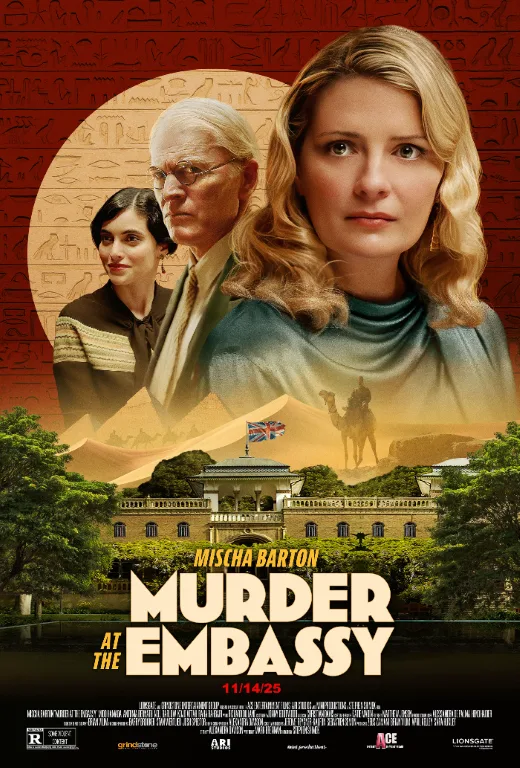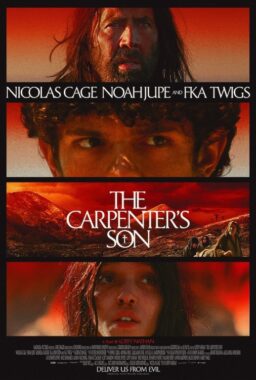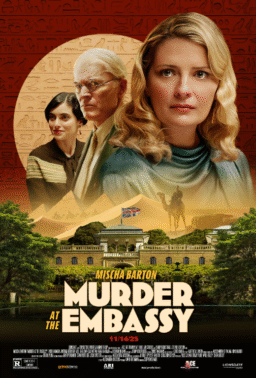Stephen Shimek’s “Murder at the Embassy” feels like one of those quick and easy reads you’d pick up at an airport bookstore on your way to your flight. Maybe it reminded you of something else you read and enjoyed. Perhaps the cover really intrigued you. But when you finally find your seat and excitedly crack open the book, it’s maybe a little too breezy as a page turner. It’s slight, not quite as exciting a time as you had hoped, but by the time the wheels have touched down again, it doesn’t matter. You’ve practically finished it already, or can at least guess where it’s going.
But for avid readers and watchers of mysteries, maybe a quick and easy case to solve isn’t necessarily a bad thing. Like a neatly packaged TV episode, “Murder at the Embassy” launches its viewers right into the heart of the mystery with an unexplained death. Then our ensemble assembles: an actress, a journalist, a translator, a secretary, an ambassador and his daughter, and the now-famous amateur detective Miranda Green (Mischa Barton) and her adorable dog, Blunder. Her reputation for solving a high-profile case precedes her, and before long, her expertise is once again called upon to find the answers after the ambassador’s secretary is found dead at the embassy. Miranda races against the clock to solve a case that only gets bigger and wilder with every new clue.
Shimek leans hard on Agatha Christie’s influence, so much so that the film’s main character, Miranda, is herself an avid reader of Christie’s and other mystery novelists in the first film, “An Invitation to a Murder,” preparing her for a new career in crime-solving. Like Christie’s Hercule Poirot, death and mystery seem to follow her, leading to her next adventure. There’s a bit of the “Knives Out” series in the mix, but this mystery movie is not trying to be topical. Instead, it’s a bit more like “Clue,” almost purposefully campy in its writing and plot twists. Both films in the Miranda Green series very much relish in the story’s 1930s period trappings, the escapist nature of Miranda’s faraway adventures, and Miranda’s detective work. It seems as if she’s grown more confident in her powers, as they now have a Sherlockian sharpness to remember everything she sees and put the clues together with superhuman speed.
Writer Mark Brennan is almost too plot-happy, throwing in twist after twist but only the most obvious clues for our brilliant detective. At one point, a copy of “Mein Kampf” gives away a Nazi spy. The dialogue is disappointingly simple, built from short declarative sentences and characters who offer little intrigue, nothing like the elegant flourishes of Agatha Christie or the propulsive prose of Sir Arthur Conan Doyle. This controversy extends to international politics and even encompasses local political efforts against British colonialism and Egypt’s royal family. It’s not for lack of effort, it’s just quite overstuffed with drama. If “Invitation to a Murder” was the series’ “Glass Onion: A Knives Out Story”/”Murder on the Orient Express” riff, “Murder at the Embassy” is the “Death on the Nile” knockoff.
As Miranda, Barton is a spunky misanthrope, someone whose forthright nature just can’t be tamed, even when it may earn her enemies. Yet as the people-adverse crime solver who really only loves animals like her dog Blunder (what a name), Barton’s performance is still relatively timid, genial, and unthreatening. Mirada occasionally needs the embassy’s resident guard to protect her in yet another disappointing shortfall. Her character lacks the gravitas of Benoit Blanc, Poirot, and Sherlock, or even the dauntless spirit of Jessica Fletcher, of “Murder, She Wrote” fame, who was also just another amateur sleuth. If you’re not already in the Miranda Green fan club, there’s not much “Murder at the Embassy” can do to impress new viewers.




















